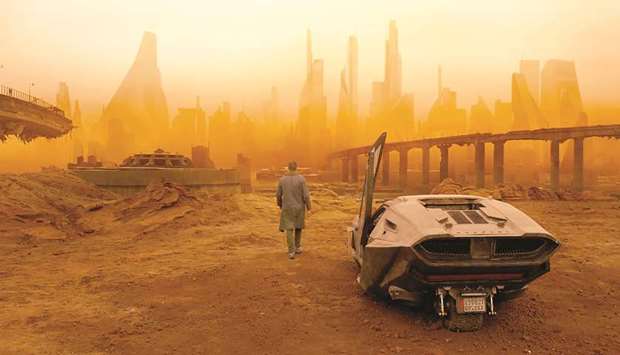“The movie we did is deeply inspired by the first movie, but we tried not to become a pastiche or parody,” says the French Canadian director behind such films as Arrival and Sicario. “We used elements from the first movie with humility and tried to find a strength in them. But this movie has its own personality.”
Adapted from Philip K. Dick’s 1968 novel Do Androids Dream of Electric Sheep?, Scott’s original film – the tale of hard-bitten cop Rick Deckard (Harrison Ford) who hunts down renegade androids – has cast a large shadow over the pop culture landscape with its gritty, haunting cyberpunk rendering of a dystopian Los Angeles. Set three decades later, after the events of the first movie, the sequel centres on a young LAPD blade runner (Ryan Gosling) who uncovers a secret that leads him on a quest to find Deckard.
Working alongside cinematographer Roger Deakins and production designer Dennis Gassner, Villeneuve, 49, sought to bring the world of Scott’s seminal classic back to life while pushing it visually in new directions. Here, Villeneuve walks us through the film, one scene at a time.
Ubiquitous advertising was a recurring visual feature of the original Blade Runner, and Villeneuve picks up that motif in this scene, as Gosling’s Officer K gazes at (and is gazed at by) an immense holographic ad. “We constructed the bridge on the set, filled the stage with rain and fog, and we projected the actress on that gigantic screen,” Villeneuve says. “So the impact of the light is all real – it’s not something created by a computer.”
Gassner was responsible for the production design on Blade Runner 2049, but for this scene, in which Officer K looks out at a ruined cityscape, Villeneuve worked with original Blade Runner concept artist Syd Mead. “For me, it was important to have one moment where Syd Mead would express himself,” he says. “I had the chance to meet the master and ask him to give me the gift to create a specific place. And when I saw his drawings, I was so moved.”
Officer K sits behind the wheel of his futuristic police cruiser, known as a spinner. “We had a few different vehicles – some were used for flight and others to drive,” Villeneuve says. “I love science fiction, but I never thought as a filmmaker that I’d have the joy to construct cars from the future like that.”
Officer K walks past cramped boxes in which some of the city’s poorest residents live, an idea inspired by real-life Hong Kong low-income housing units called “coffin cubicles.” “Part of LA is in ruins and doesn’t have power anymore, and there are a lot of refugees coming from eastern Asia and Russia,” Villeneuve says. “To have your own apartment is a big luxury, and there are a lot of people living in boxes.”
Actress Sylvia Hoeks, who plays a character called Luv, looks into a retinal scanner alongside Gosling’s Officer K. “The image of the eye was very important in Ridley Scott’s universe and those elements are in 2049 as well,” Villeneuve says. “There’s the cliche that the eyes are windows of the soul, and we’re dealing with replicants who don’t have a soul.”
For Villeneuve, shown here on the set, it was critically important to incorporate real, tangible props, like this table with decanters and cocktails, with which the actors could interact. “At the end of the day, the actors need realism around them to be inspired,” the director says. “They can go deeper into the scene and deeper into the psyche of the character if they don’t have to deal with a fake glass on a fake table.”
In the original Blade Runner, Ford’s Deckard was constantly soaked by rain, but in the new film, the weather is much less predictable. In the intervening years, the climate has gone berserk due to rampant pollution, turning Los Angeles into a chilly, desolate place. “As much as the first movie had an atmosphere of constant rain, in this one it would be colder,” the director says. “Basically, you could say that the first movie was made by a man from London, England, and the second one was made by someone from Montreal, Canada.”
With the new Blade Runner, Villeneuve wanted to carry forward the neo-noir aesthetic of the original film, with stark, dramatic lighting as in this scene featuring Gosling and Ford. “It’s a world that is quite bleak and dark and claustrophobic, but I tried to find an equilibrium with explosions of colour that would express some emotions and some themes,” he says. “The colour yellow is very important in the movie and is linked with different aspects, story-wise.”
With Blade Runner 2049, Villeneuve was determined to keep the production as old school as he could, putting his cast onto real sets, like this building through which K and Deckard are running. “The first question Ryan asked me was, ‘Will we do the whole movie in front of green screen?’” he says. “You need to allow the space for the actors to find new ideas on the set – and those ideas are not coming in front of a green screen. For me, I understand the power of it, but I hate it.”
Villeneuve, shown here in front of one of the film’s spinners, says trying to revive and expand the sci-fi universe that Scott created 35 years ago is by far the biggest artistic challenge he’s ever undertaken. “My respect and admiration for Ridley Scott cannot be higher than now after having done this movie,” he says. “From a design point of view, he is a genius. Once you try to do it yourself, you realise how difficult what he did is.” – TNS

